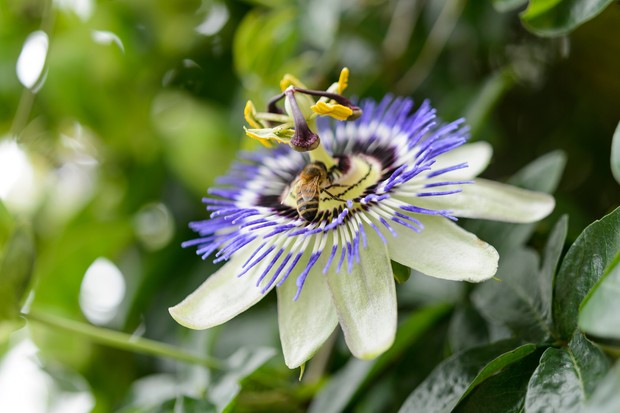
There’s a wide variety of climbers to choose from, ranging from ‘true climbers’ that naturally have a climbing habit, to shrubs which can be trained to grow against a wall, given the correct pruning and support. Some are annual and will quickly cover a feature in a season, perhaps while you wait for a perennial climber or wall shrub to fill the space. Many climbers are self-clinging, meaning you don’t have to provide a structure for them, while others will need tying in.
Browse our pick of the best fast-growing climbers to grow, including annuals and perennials, self-clingers and wall shrubs.
Climbers are worth their weight in gold for wildlife, clothing walls and fences, and hiding unsightly views. They also add ornamental interest with pretty foliage and flowers, many of which are scented. Plus, large vertical surfaces allow climbers the space they need to spread out, for full dramatic effect.
Climbing plants fall into three categories: climbing and rambling roses, and pyracantha, ramble over a structure and need initial training and tying in. Others, such as honeysuckle and clematis, entwine themselves around a structure, and need initial tying in before they become established. Self-clingers such as ivy and climbing hydrangea need no support at all and can support themselves.
Discover 10 climbers to grow.
A bare fence isn’t much use to wildlife – birds can’t nest in it, butterflies can’t hibernate in it, and bees, caught in a sudden downpour, can’t fly use it for shelter. Cover it in climbers, however, and it’s a different story – even a single plant can support a range of wildlife species.
Here are 10 climbers that not only look good but are great for wildlife, too.
Climbing plants are worth their weight in gold, clothing walls and fences, and hiding unsightly views.
1
Passion flower
Climbers for wildlife – passion flower
Passion flower has dark, evergreen leaves and exotic-looking flowers. It provides general shelter for insects and birds, and nectar for some pollinators.
2
Honeysuckle

Climbers for wildlife – honeysuckle
Scented honeysuckles come in a range of colours, from dark red to yellow. They provide shelter for nesting birds, nectar for pollinators (including moths), leaves for caterpillars of the 20-plume moth, and berries for birds. Our native Lonicera periclymenum is ideal – the variety ‘Graham Thomas’ is said to be the closest cultivar to our native species.
3
Hops

Climbers for wildlife – hops
Humulus lupulus provides shelter for insects and leaves for caterpillars, including the comma butterfly.
4
Ivy

Climbers for wildlife – ivy
Ivy (Hedera helix) provides long-lasting, evergreen cover. It provides shelter for nesting birds and hibernating insects, nectar for pollinators, berries for birds and leaves for caterpillars (including the holly blue butterfly).
5
Star jasmine

Climbers for wildlife – star jasmine
Trachelospermum jasminoides is a woody evergreen climber with dark leaves and white, fragrant flowers. It provides general shelter for birds and insects, and flowers for pollinators.
6
Wisteria

Climbers for wildlife – wisteria
Wisteria is a stunning woody climber with clusters of lightly fragrant, lilac flowers in spring. It provides shelter for nesting birds and insects.
7
Clematis

Climbers for wildlife – clematis
When established, all clematis provide nesting shelter for a variety of birds and other species. However, cultivars of Clematis tangutica, including ‘Bill MacKenzie’ (pictured) also provides nectar and pollen for bees, followed by wispy seedheads in autumn. If you leave the seedheads in place birds will take the material to use in their nests in spring.
8
Climbing hydrangea

Climbers for wildlife – climbing hydrangea
Hydrangea anomala subsp. petiolaris, or climbing hydrangea, is a popular climber. Like all climbers it provides shelter for a variety of different species, including nesting birds. It’s tolerant of shade and is therefore useful for growing up a north-facing wall. However, if you grow it on a south-facing wall, its flowers are a magnet for pollinating hoverflies and other insects.
9
Climbing roses

Climbers for wildlife – climbing rose
Some climbing and rambling roses are better for wildlife than others. Mature plants provide cover and shelter for a wide variety of wildlife, including nesting birds. However, if you choose a variety with single, open flowers, you will provide nectar and pollen for pollinators, followed by hips for birds. What’s more, the leaves of some species of rose, such as the variety ‘Frances E. lester’ will also be used by leafcutter bees to line their nests.
10
Pyracantha

Climbers for wildlife – pyracantha
Pyracantha flowers in spring and bears berries in autumn, providing two seasons of food for wildlife.
Want to attract more wildlife to your garden? Discover the 10 best herbs for wildlife.
Avoid the ‘rain shadow’ when planting
It’s important to avoid the ‘rain shadow’ – the area immediately beneath a wall or fence where the rain doesn’t fall and where conditions are too dry for most plants to grow successfully. Plant climbers 45cm away, at an angle, to avoid it.

Other plants to try

Climbers for wildlife – dog rose
Field rose, Rosa arvensis – glossy leaves on arching stems, plus white flowers
Dog rose, Rosa canina – a climbing rose with lots of pink flowers and a yellow centre
Old man’s beard, Clematis vitalba – our native clematis, with pretty white flowers and fluffy seedheads
